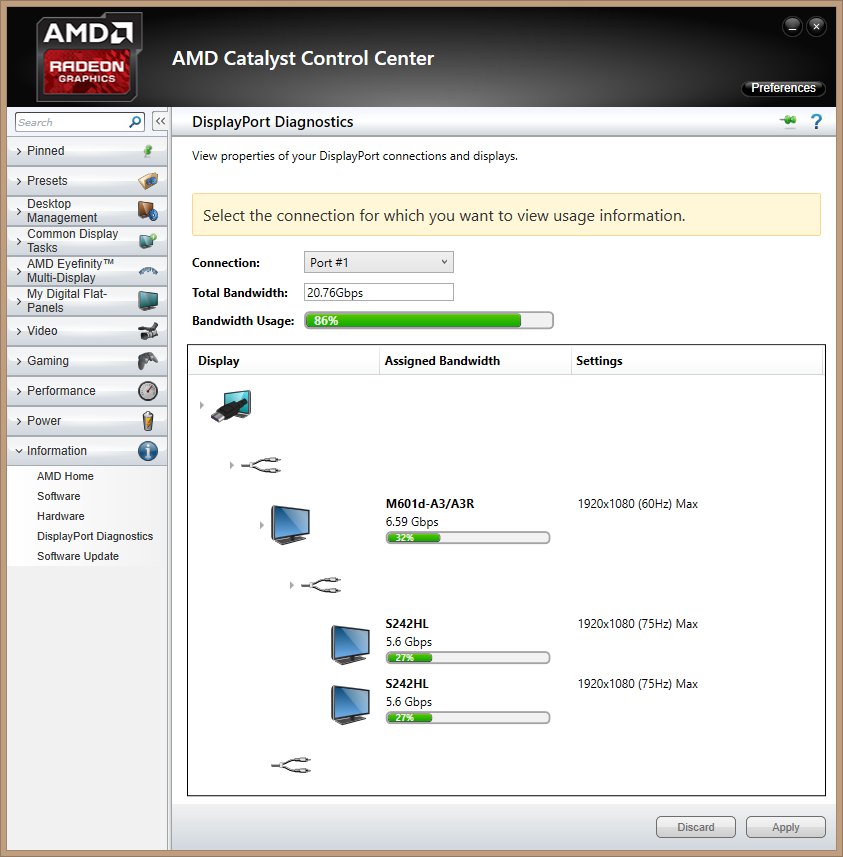Hello world of Club3D, my name is Nicole and I recently purchased the
Club3D Multi Streaming Hub (CSV-5300H) from Amazon.com.
I have scoured the forums and all over the internet for 2 days now, and I have decided to ask the question directly myself on the official forums.
It seems to work perfectly fine with my normal displays, e.g. 3x S242HL 60Hz 24″ LCD Panels, and in mixed configurations with my flat-panel 60″ TV directly next to the desktop computer itself.
You can see the configuration here in the AMD Catalyst Control Center:

The Situation:
This is a two-part problem. I run the monitors at 60Hz each, but the AMD Displayport Diagnostic utility of the Catalyst Control Center shows that the S242HL Monitors are eating up the bandwidth equivalent to 1920×1080 (75Hz) when they most certainly are not using 75Hz. Normally this would not be a problem, but I am running display emulation adapters called HeadlessGhosts, originally a project started and successfully funded on Kickstarter.com, that virtualize a monitor of almost any frequency/refresh rate and resolution from 640×480 @ 25Hz all the way up to 4k @ 240Hz. Seen here: https://www.kickstarter.com/projects/devjoshi/headless-ghost/description
While the adapters were originally designed for headless servers and server farms, the developer of them modified their EDID settings with more resolutions and refresh-rates specifically for the Oculus Rift. The point of the several HeadlessGhost adapters (in my scenario) is to virtualize monitors within a 3-Dimensional space inside of the Oculus Rift Head-Mounted Virtual Reality Display. Seen here: https://www.oculus.com/dk2/
I use custom-developed software called Virtual Desktop (Seen here: http://vrdesktop.net/) to use the HeadlessGhosts as workable virtual environments within the virtual reality headset, and this works fine for the real-life S242HL 24″ LCD panels, and when the HeadlessGhost adapters are plugged directly into the available GPU ports. As you can see, each S242HL panel uses about 5.6Gbps per panel (Even though none of them are running at 75Hz, just 60Hz), well within bandwidth limitations of the DisplayPort 1.2 standard being used on the MST Hub.
As I previously illustrated, the S242HL panels are eating up a quoted 5.6Gbps per lane of the MST Hub, being quoted at 75Hz per panel, EVEN THOUGH they don’t actually operate at 75Hz unless the resolution is lowered to an insanely low resolution. This problem is exponentially larger when you plug a HeadlessGhost into one of the 3 lanes of the MST Hub. Immediately the Displayport Diagnostics window will report that the HeadlessGhost is eating up about 17.0 Gbps of the MST Hub’s available DisplayPort bandwidth. And even though the HeadlessGhost is being instructed to operate at 1920×1080 @ 60Hz @ What SHOULD be 5.6Gbps per headless ghost, instead the diagnostic window reports that the headless ghost is running at 4k Resolution @ 240Hz, which is WAY over what it is supposed to be operating at, and as a direct result of this, I am unable to add any additional HeadlessGhosts to the MST Hub, because there is “Insufficient Bandwidth” to add any more displays to the Hub.
Can you tell me why it is doing this? I have tried to modify registry-based EDID values using Custom Resolution Utlity on each of the HeadlessGhost display adapters to only showing 1920×1080 @ 75Hz, and it does not affect the DisplayPort Bandwidth what-so-ever, and I am too afraid to actually flash the EDID chips of the adapters using things like “PowerStrip”, which may permanently damage the adapters themselves.
So are there software workarounds, is there a foundational science behind why it uses the maximum potential of the adapters and S242HL displays to account for available bandwidth? Any why does it eat the bandwidth of 75Hz even though none of the displays are running at 75Hz? (The HeadlessGhosts are designed to operate between 25Hz and 240Hz)

